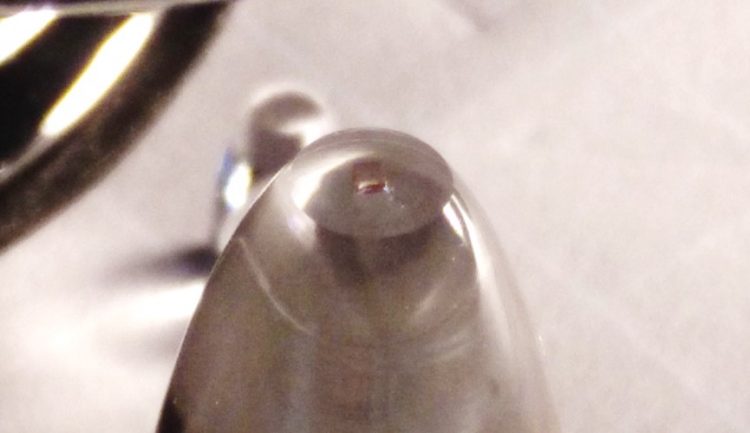MiLiQuant: Putting quantum technology into practice

A diamond on a parabolic light collecting lens is the main component of the new angular rate sensor. photo/©: Arne Wickenbrock
Quantum technology is about to make the leap from scientific research to concrete applications. Contributing to this is the new MiLiQuant research project in which businesses and universities are cooperating to develop new applications for quantum technology.
The German Federal Ministry of Education and Research (BMBF) will be supporting the project to the tune of approximately EUR 9.4 million over the next three years to early 2022. Johannes Gutenberg University Mainz (JGU) and Robert Bosch GmbH in Gerlingen are partners in the MiLiQuant project. Further partners are Q.ant GmbH in Stuttgart, Carl Zeiss AG in Jena, Nanoscribe GmbH in Eggenstein-Leopoldshafen, and Paderborn University.
In the collaborative project MiLiQuant, short for “Miniaturized light sources for use in industrial quantum sensors and quantum imaging devices”, the researchers enhance diode laser beam sources so that they can be employed in industrial quantum technology applications.
The goal is to develop miniaturized, frequency- and power-stable beam sources that can also be used outside laboratories. These core technologies are being customized to meet the requirements of specific applications in quantum sensor technology and quantum imaging.
Mainz University and Robert Bosch GmbH are collaborating in the production of gyroscopes
Miniaturized light sources are required in industrial sensors and imaging systems. The participants in the collaborative project are focusing on the research and development of compact industrial light sources with output powers of up to one watt. Such light sources either directly employ quantum mechanical phenomena themselves or enable quantum mechanical effects to be harnessed.
To demonstrate the feasibility of quantum sensors, scientists of the Quantum, Atomic, and Neutron Physics (QUANTUM) group at the Institute of Physics at JGU and Robert Bosch GmbH are developing two gyroscopes or angular rate sensors, one use of which may be to ensure driverless vehicles remain in the same lane. “We are developing one sensor based on nuclear spin comagnetometry with alkali gas cells, while another is based on color centers in diamonds,” explained Dr. Arne Wickenbrock, a researcher in QUANTUM and at the Helmholtz Institute Mainz (HIM). “The latter, in particular, offers great potential for miniaturization.”
Other possible applications to be developed through the collaborative project include the utilization of diamond-based sensors in medical diagnostics to detect, for instance, brain and nerve activity during surgery, quantum sensors for non-invasive monitoring of neural activity and heart rate in unborn babies, and reduced-radiation microscopy in the mid-infrared range.
Image:
http://www.uni-mainz.de/bilder_presse/08_physik_quantum_miliquant.jpg
A diamond on a parabolic light collecting lens is the main component of the new angular rate sensor.
photo/©: Arne Wickenbrock
Related links:
https://www.photonikforschung.de/projekte/quantentechnologien/projekt/miliquant…. – MiLiQuant research project [in German]
https://www.hi-mainz.de/ – Helmholtz Institute Mainz (HIM)
Read more:
http://www.uni-mainz.de/presse/aktuell/6862_ENG_HTML.php – press release “Full steam ahead to the quantum web: Mainz University is involved in European Flagship on Quantum Technologies program” (30 Oct. 2018)
Dr. Arne Wickenbrock
Helmholtz Institute Mainz (HIM) and
Quantum, Atomic, and Neutron Physics (QUANTUM) group
Institute of Physics
Johannes Gutenberg-Universität Mainz
55099 Mainz, GERMANY
phone +49 6131 39-29636
e-mail: wickenbr@uni-mainz.de
Media Contact
All latest news from the category: Physics and Astronomy
This area deals with the fundamental laws and building blocks of nature and how they interact, the properties and the behavior of matter, and research into space and time and their structures.
innovations-report provides in-depth reports and articles on subjects such as astrophysics, laser technologies, nuclear, quantum, particle and solid-state physics, nanotechnologies, planetary research and findings (Mars, Venus) and developments related to the Hubble Telescope.
Newest articles

Superradiant atoms could push the boundaries of how precisely time can be measured
Superradiant atoms can help us measure time more precisely than ever. In a new study, researchers from the University of Copenhagen present a new method for measuring the time interval,…

Ion thermoelectric conversion devices for near room temperature
The electrode sheet of the thermoelectric device consists of ionic hydrogel, which is sandwiched between the electrodes to form, and the Prussian blue on the electrode undergoes a redox reaction…

Zap Energy achieves 37-million-degree temperatures in a compact device
New publication reports record electron temperatures for a small-scale, sheared-flow-stabilized Z-pinch fusion device. In the nine decades since humans first produced fusion reactions, only a few fusion technologies have demonstrated…





















